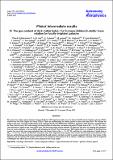Por favor, use este identificador para citar o enlazar a este item:
http://hdl.handle.net/10261/109580COMPARTIR / EXPORTAR:
 SHARE SHARE
 CORE
BASE CORE
BASE
|
|
| Visualizar otros formatos: MARC | Dublin Core | RDF | ORE | MODS | METS | DIDL | DATACITE | |

| Título: | Planck intermediate results: XI. the gas content of dark matter halos: The Sunyaev-Zeldovich-stellar mass relation for locally brightest galaxies |
Autor: | Rubiño-Martín, J. A.; Barreiro, R. Belén CSIC ORCID ; Diego, José María CSIC ORCID ; González-Nuevo, J. CSIC ORCID; Herranz, D. CSIC ORCID ; López-Caniego, M. CSIC ORCID; Martínez-González, Enrique CSIC ORCID ; Toffolatti, L. CSIC ORCID; Vielva, Patricio CSIC ORCID ; Rebolo López, Rafael CSIC ORCID; Planck Collaboration | Palabras clave: | Large-scale structure of the universe Galaxies: clusters: general Cosmic background radiation Cosmology: observations |
Fecha de publicación: | 2013 | Editor: | EDP Sciences | Citación: | Astronomy and Astrophysics 557: A52 (2013) | Resumen: | We present the scaling relation between Sunyaev-Zeldovich (SZ) signal and stellar mass for almost 260,000 locally brightest galaxies (LBGs) selected from the Sloan Digital Sky Survey (SDSS). These are predominantly the central galaxies of their dark matter halos. We calibrate the stellar-to-halo mass conversion using realistic mock catalogues based on the Millennium Simulation. Applying a multi-frequency matched filter to the Planck data for each LBG, and averaging the results in bins of stellar mass, we measure the mean SZ signal down to M∗ ~ 2 × 1011 M⊙, with a clear indication of signal at even lower stellar mass. We derive the scaling relation between SZ signal and halo mass by assigning halo properties from our mock catalogues to the real LBGs and simulating the Planck observation process. This relation shows no evidence for deviation from a power law over a halo mass range extending from rich clusters down to M500 ~ 2 × 1013 M⊙, and there is a clear indication of signal down to M500 ~ 4 × 1012 M⊙. Planck’s SZdetections in such low-mass halos imply that about a quarter of all baryons have now been seen in the form of hot halo gas, and that this gas must be less concentrated than the dark matter in such halos in order to remain consistent with X-ray observations. At the high-mass end, the measured SZ signal is 20% lower than found from observations of X-ray clusters, a difference consistent with the magnitude of Malmquist bias effects that were previously estimated for the X-ray sample. | Versión del editor: | http://dx.doi.org/10.1051/0004-6361/201220941 | URI: | http://hdl.handle.net/10261/109580 | DOI: | 10.1051/0004-6361/201220941 | Identificadores: | doi: 10.1051/0004-6361/201220941 issn: 0004-6361 e-issn: 1432-0746 |
| Aparece en las colecciones: | (IFCA) Artículos |
Ficheros en este ítem:
| Fichero | Descripción | Tamaño | Formato | |
|---|---|---|---|---|
| XI. The gas content of dark.pdf | 2,35 MB | Adobe PDF |  Visualizar/Abrir |
CORE Recommender
SCOPUSTM
Citations
62
checked on 13-abr-2024
WEB OF SCIENCETM
Citations
129
checked on 29-feb-2024
Page view(s)
311
checked on 19-abr-2024
Download(s)
199
checked on 19-abr-2024
Google ScholarTM
Check
Altmetric
Altmetric
NOTA: Los ítems de Digital.CSIC están protegidos por copyright, con todos los derechos reservados, a menos que se indique lo contrario.
